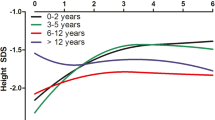Abstract
Steroid withdrawal after renal transplantation and cyclosporine-based immunosuppression enhances growth in children, but this practice is not widely employed because of a 50%–60% rate of rejection, graft dysfunction, or graft loss. The current study evaluates growth and renal function after withdrawal and discontinuation of steroids within 1 year of transplantation in 52 children receiving tacrolimus (FK-506)-based immunosuppression. Height Z-score, weight-for-height index (WHI), and body mass index (BMI), as well as graft loss and calculated creatinine clearance as a measure of glomerular filtration rate (GFR), were assessed. Children were divided into three groups according to age at transplantation: group I, 16 children aged 0–5 years; group II, 17 children aged 6–12 years; group III, 19 children aged 13–16 years. Significant and sustained improvement in height occurred in groups I and III, with Z-scores increasing by 1.51 and 1.57 standard deviations at 3 years after transplantation compared with the Z-score at transplantation (P<0.02). Mean WHI values remained near 100% in groups I and III, and significantly increased above 100% only in group II at 2 years after transplantation. Although actual BMI scores improved significantly in groups II and III at both 2 and 3 years post transplantation (P<0.05), when BMI scores were adjusted for height age, none of these groups had values >95% denoting obesity. Failure of steroid withdrawal, defined as reinstitution of steroids, graft dysfunction, or graft loss, occurred in 9 of 68 (13%) children who underwent steroid withdrawal at any time after transplantation, and resulted in graft dysfunction or graft loss in 5 (7%). Over a 3-year period, rates of renal dysfunction, as manifested by >50% rise in the serum creatinine level above baseline, or graft loss were lower in these 68 children compared with 8 children who never had steroid withdrawal (P<0.05). Mean GFR at 3 years after transplantation ranged from 96 to 102 ml/min per 1.73 m2 in all three steroid withdrawal groups, and remained stable during the 3 years of follow-up. These data indicate that steroid withdrawal enables normalization of growth without obesity, and without imposing an excessive risk for graft dysfunction or graft loss.
Similar content being viewed by others
Author information
Authors and Affiliations
Additional information
Received: 29 March 1999 / Revised: 23 December 1999 / Accepted: 2 January 2000
Rights and permissions
About this article
Cite this article
Ellis, D. Growth and renal function after steroid-free tacrolimus-based immunosuppression in children with renal transplants. Pediatr Nephrol 14, 689–694 (2000). https://doi.org/10.1007/s004670000335
Issue Date:
DOI: https://doi.org/10.1007/s004670000335




